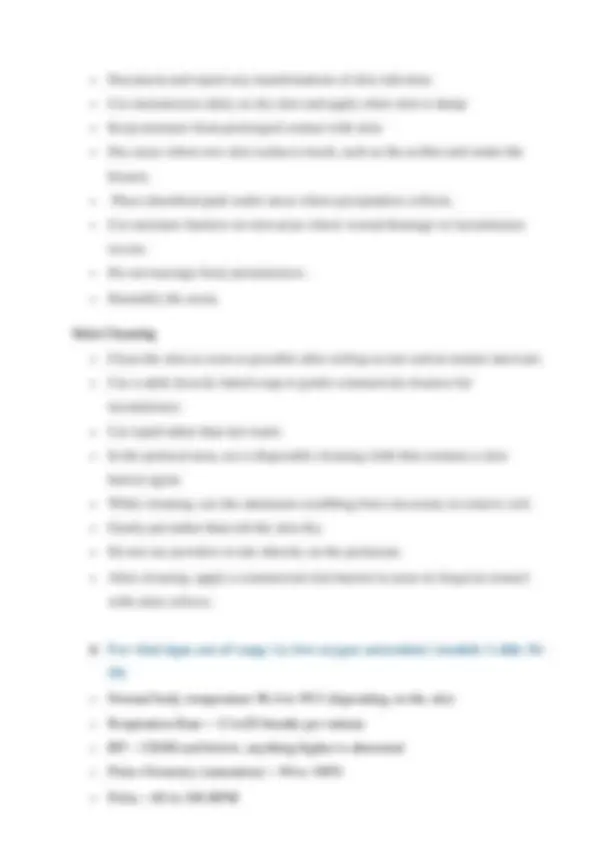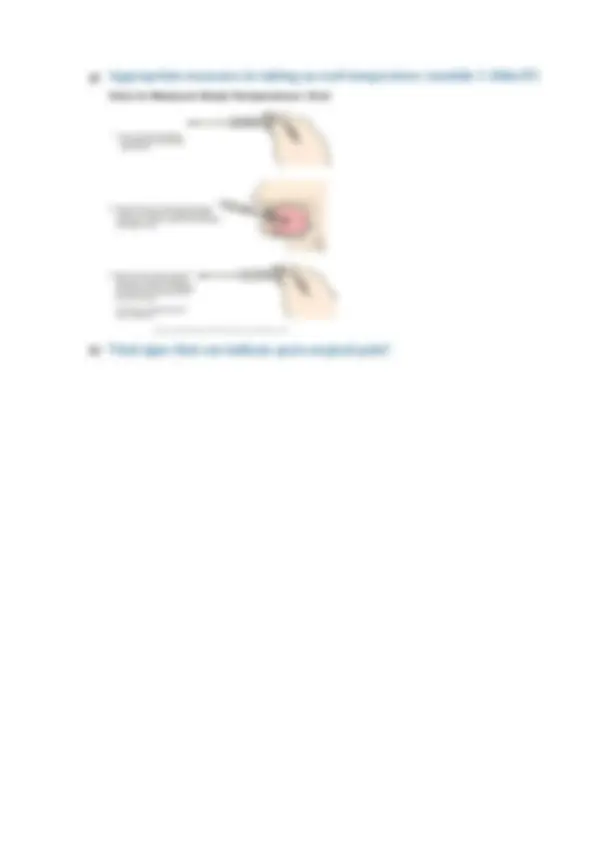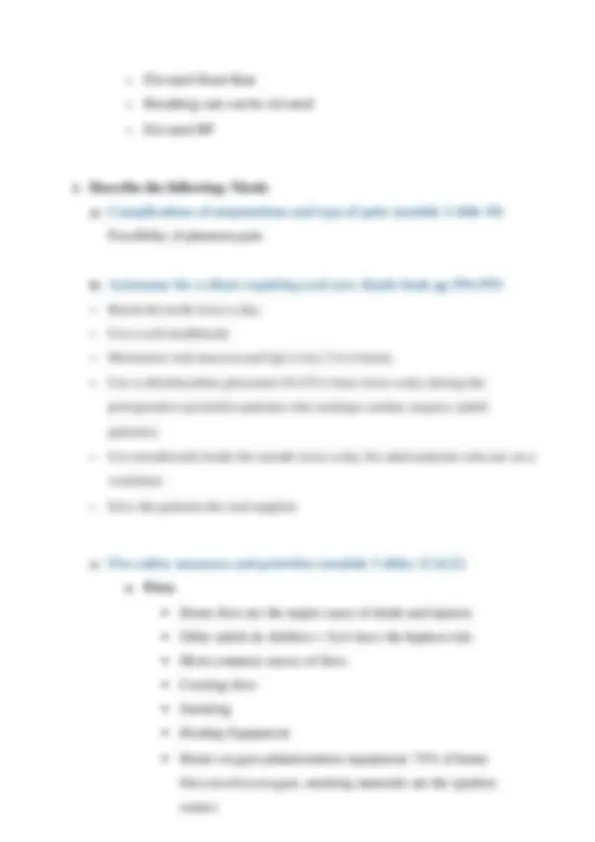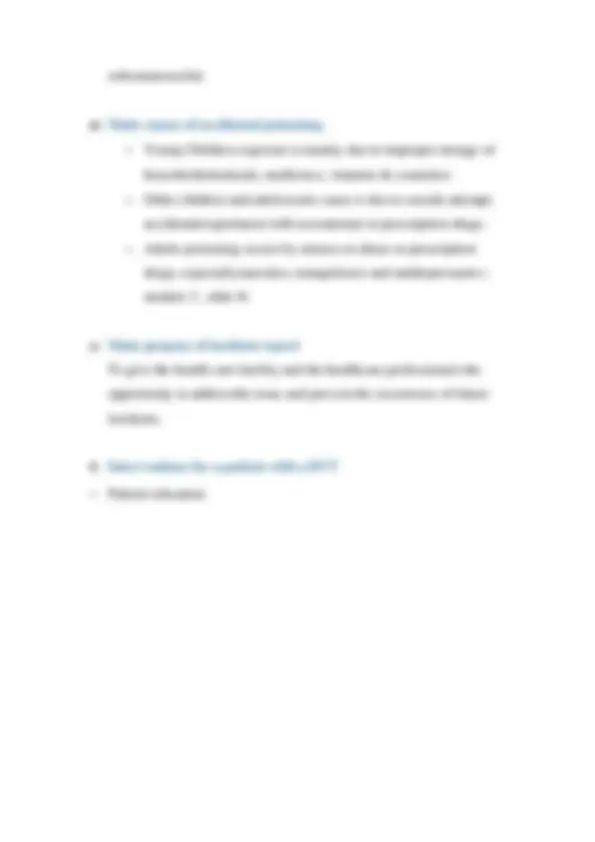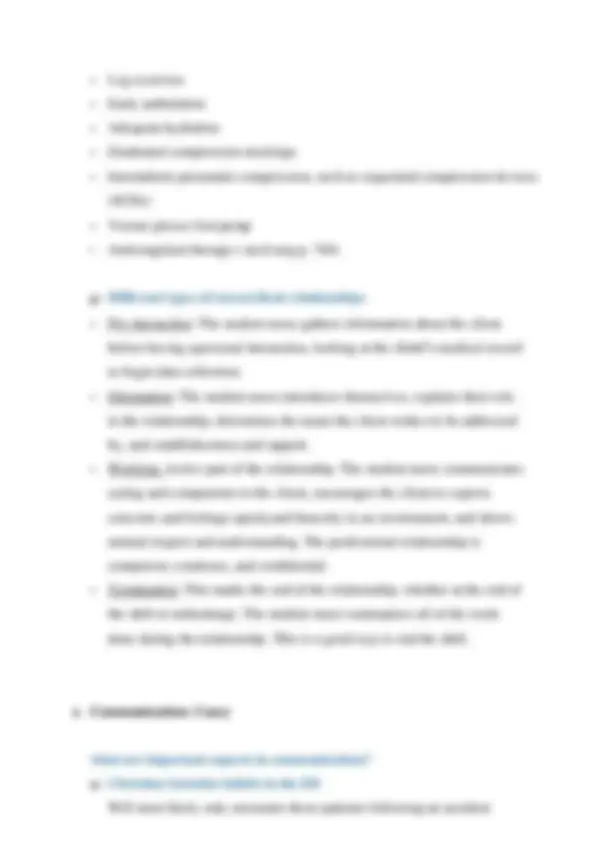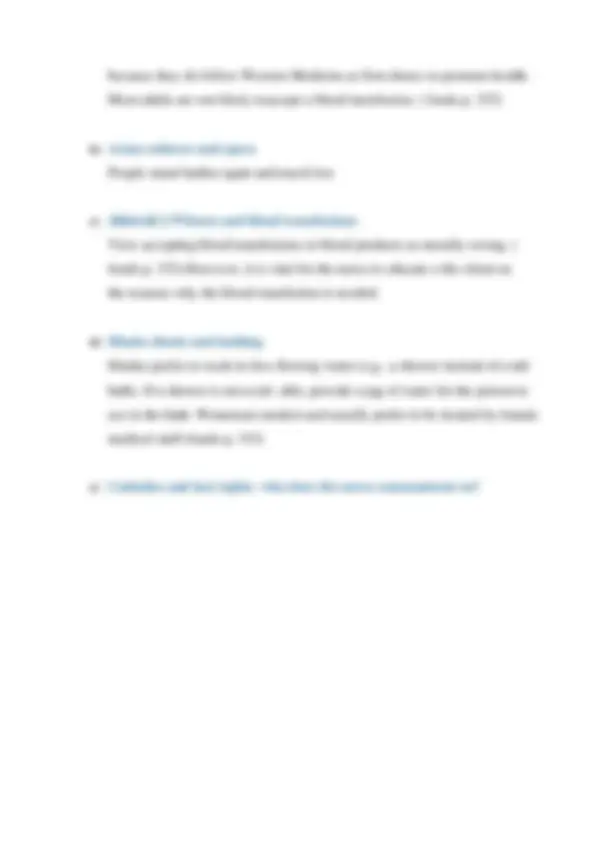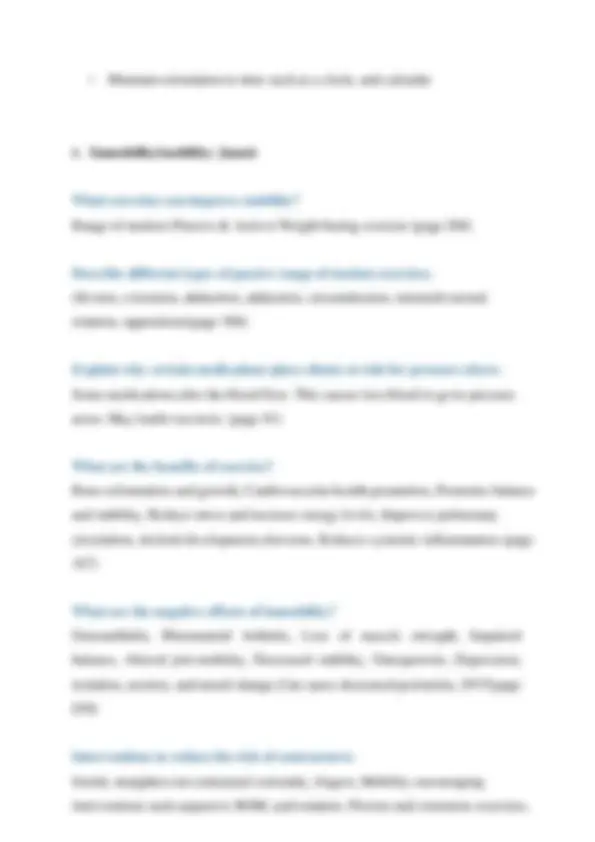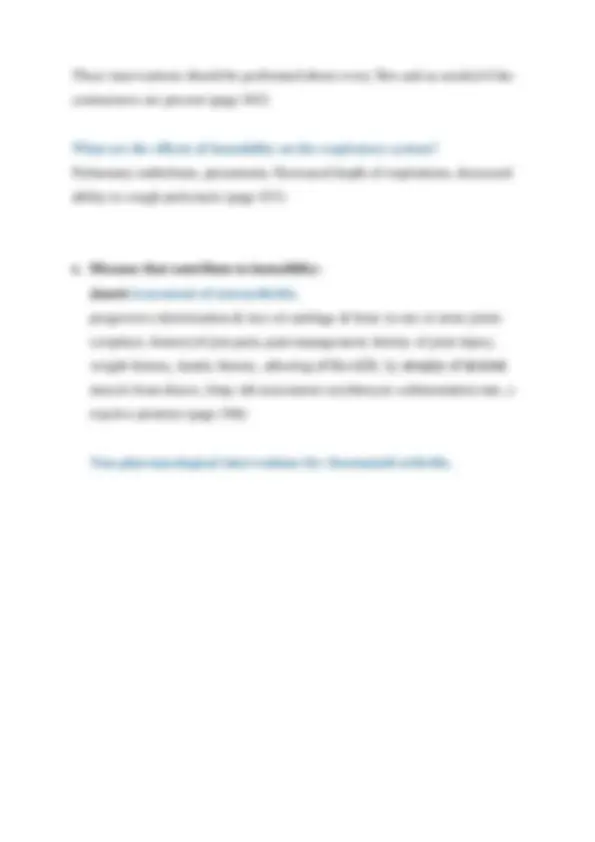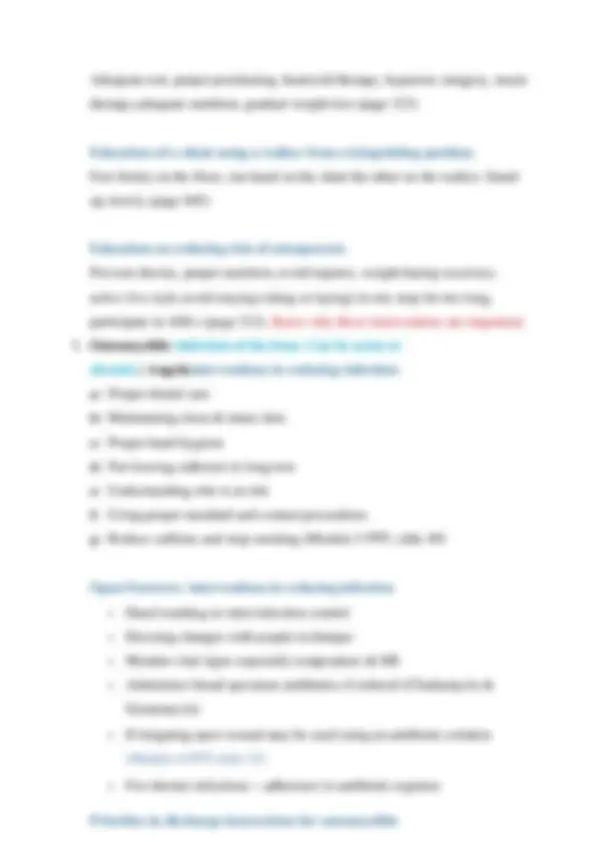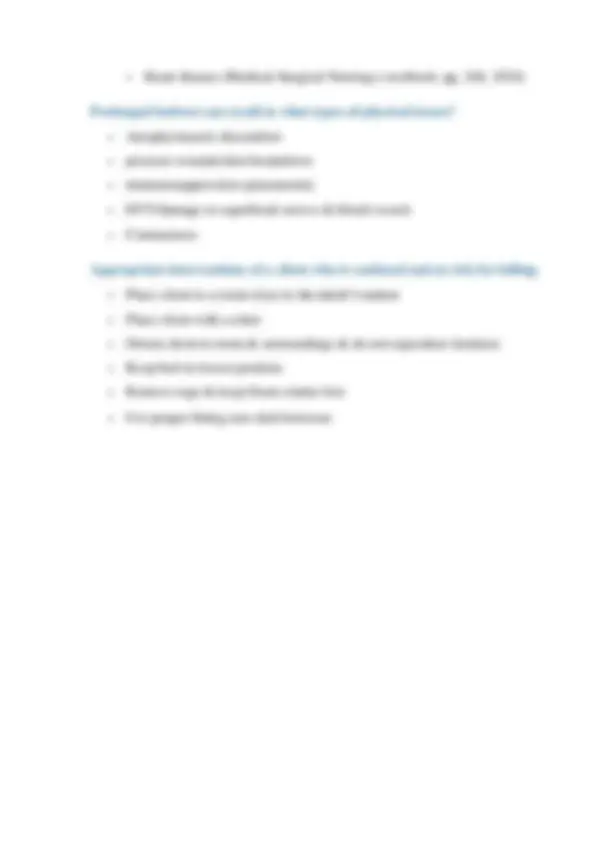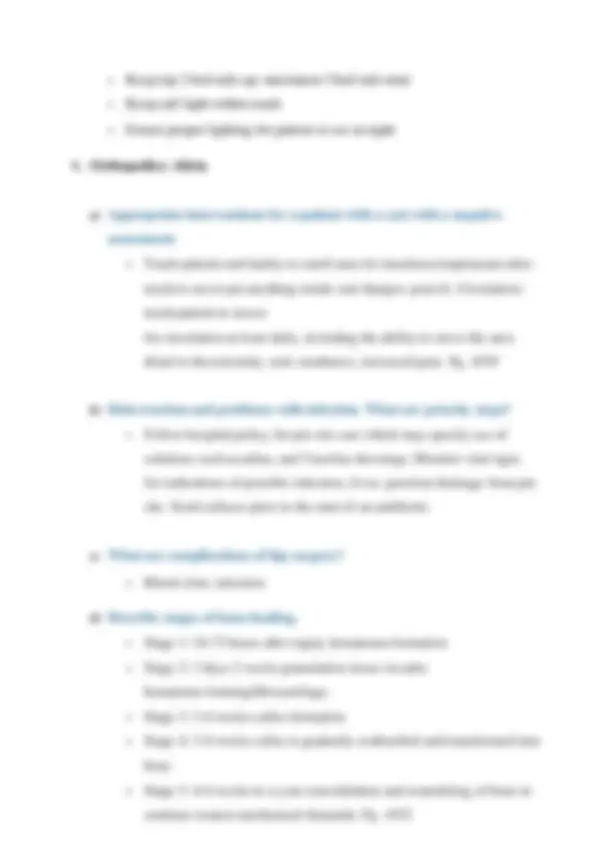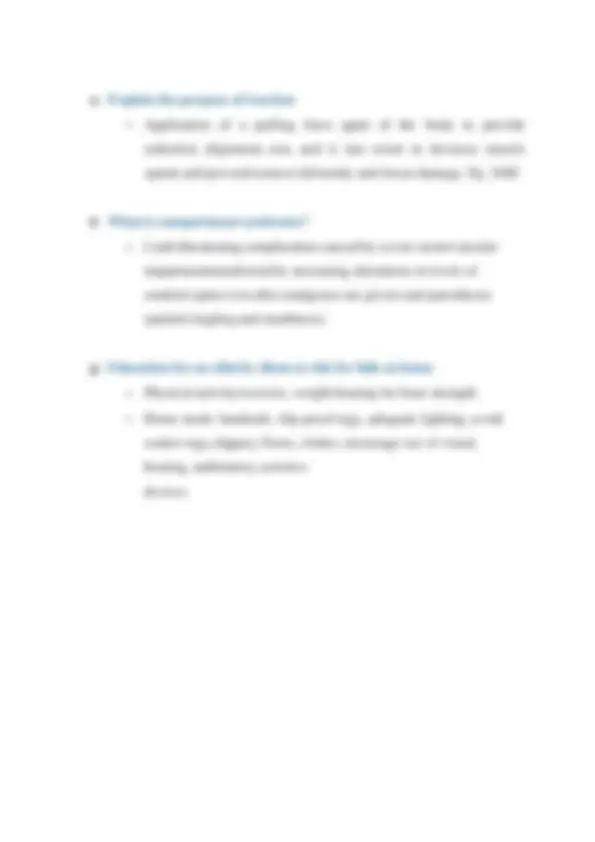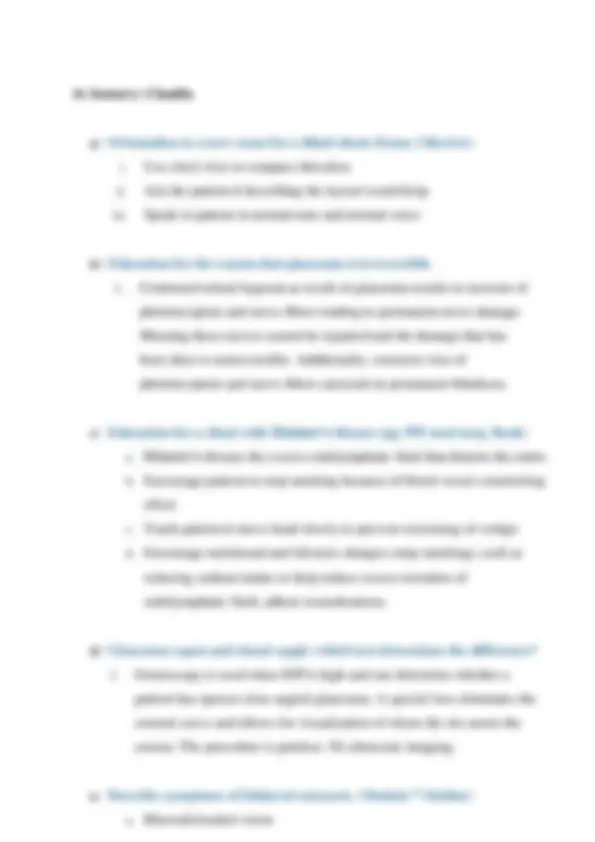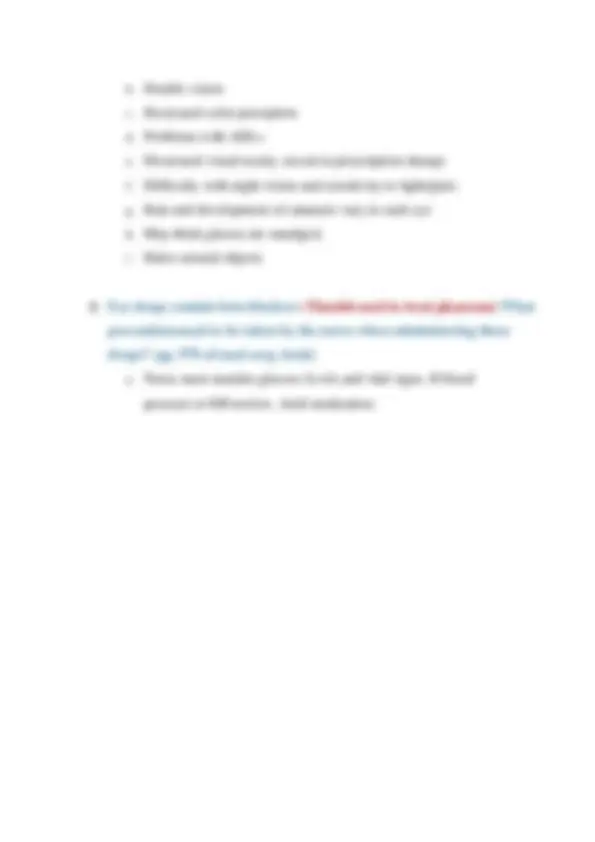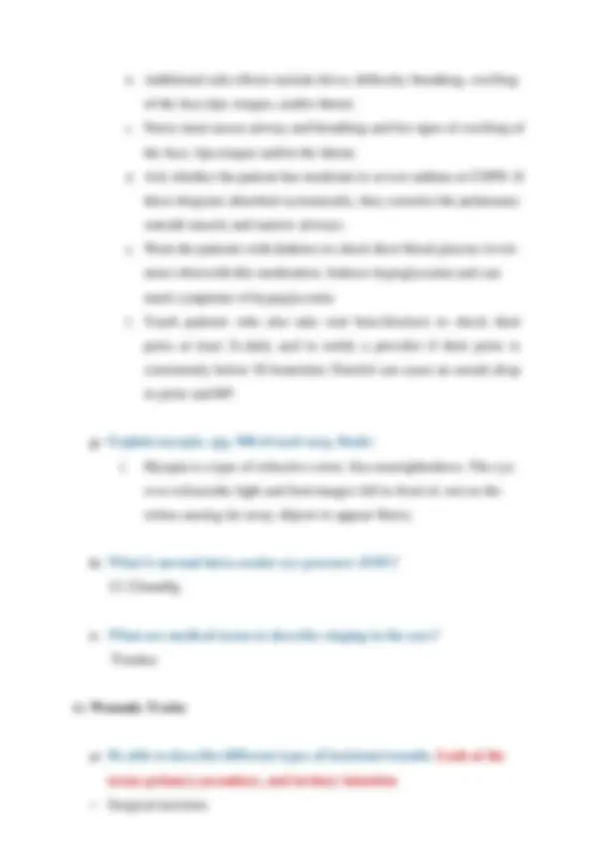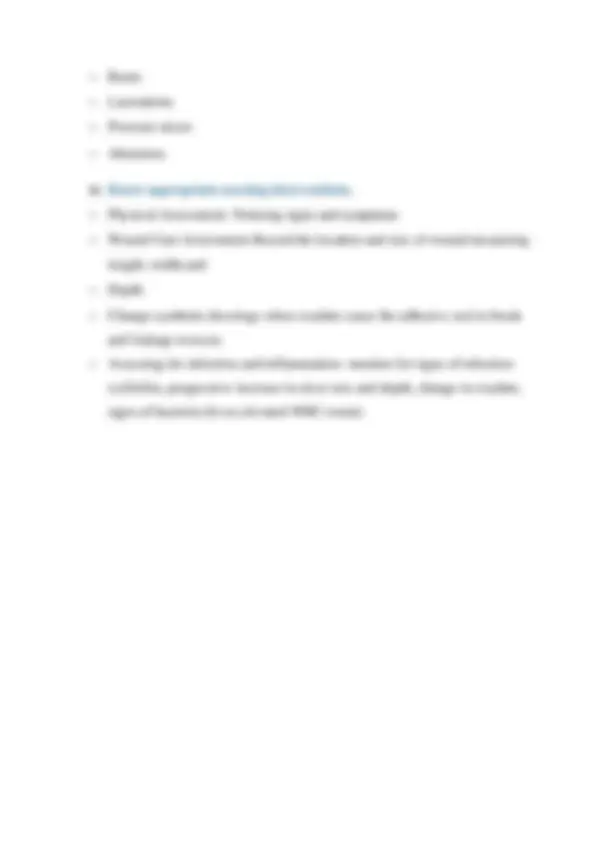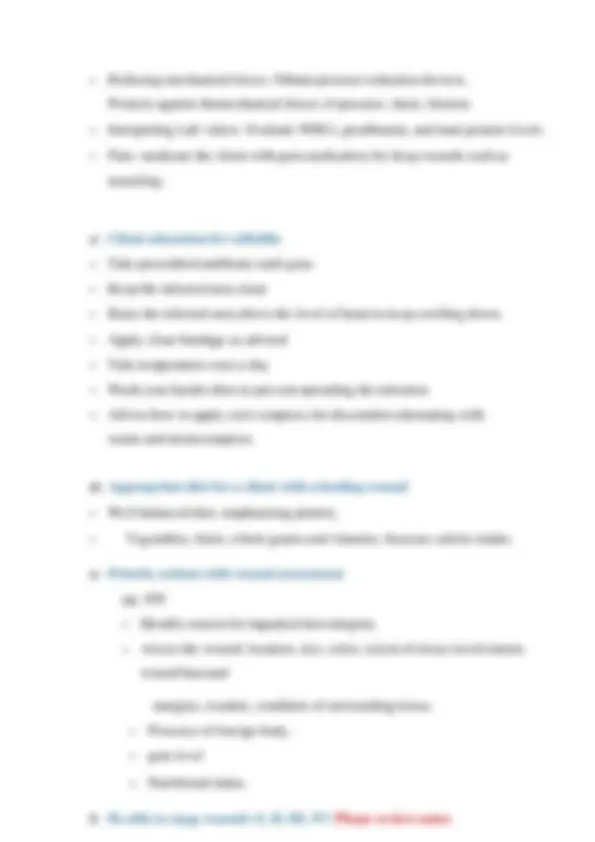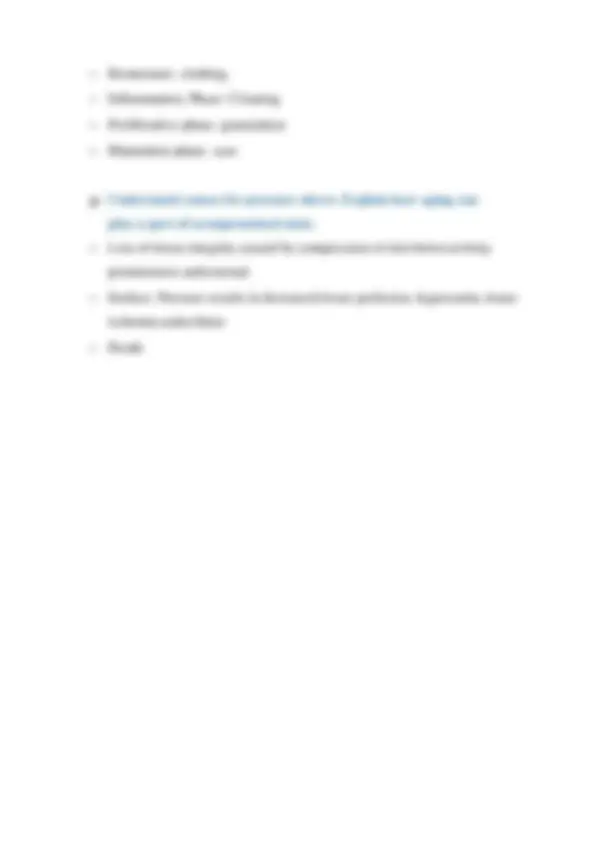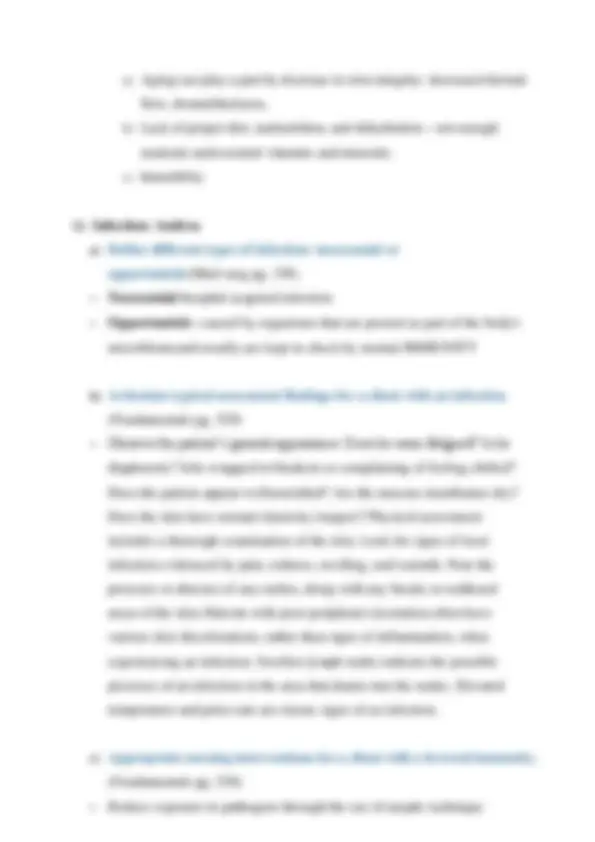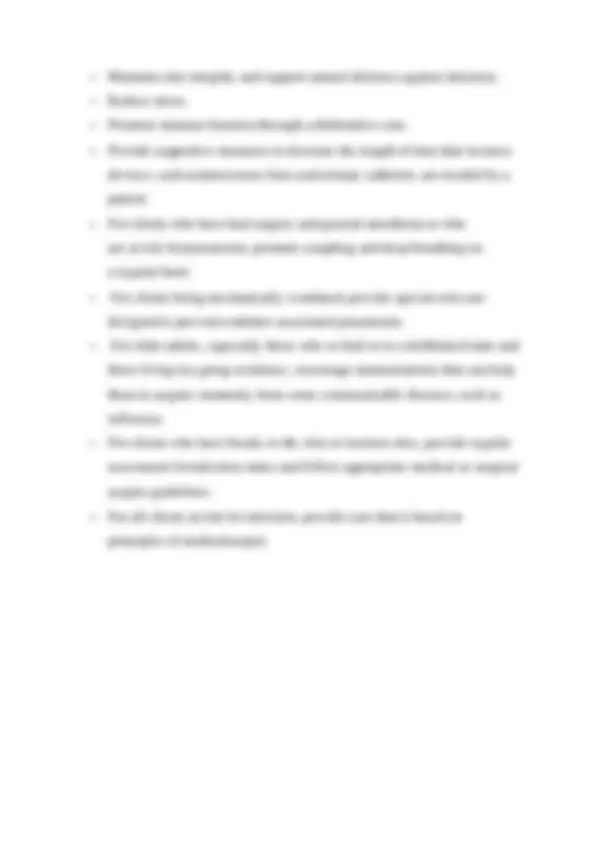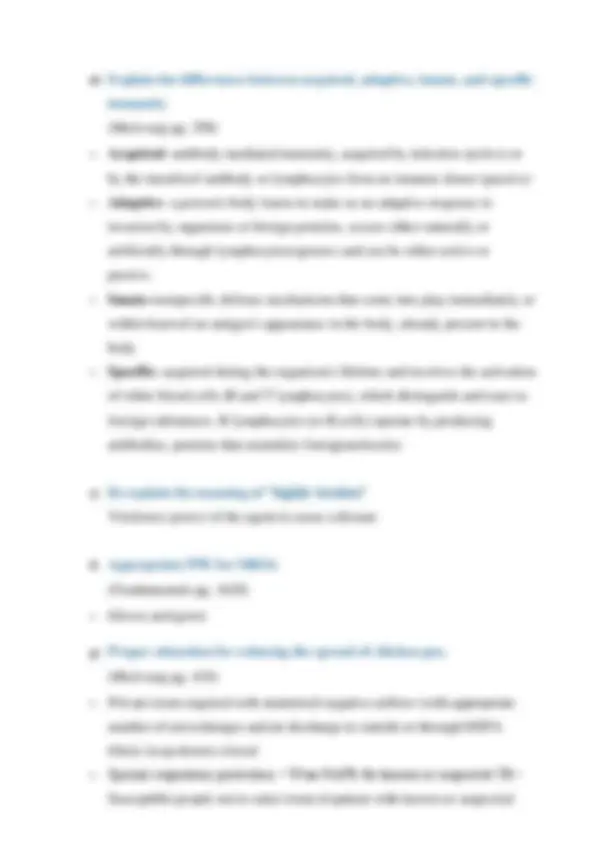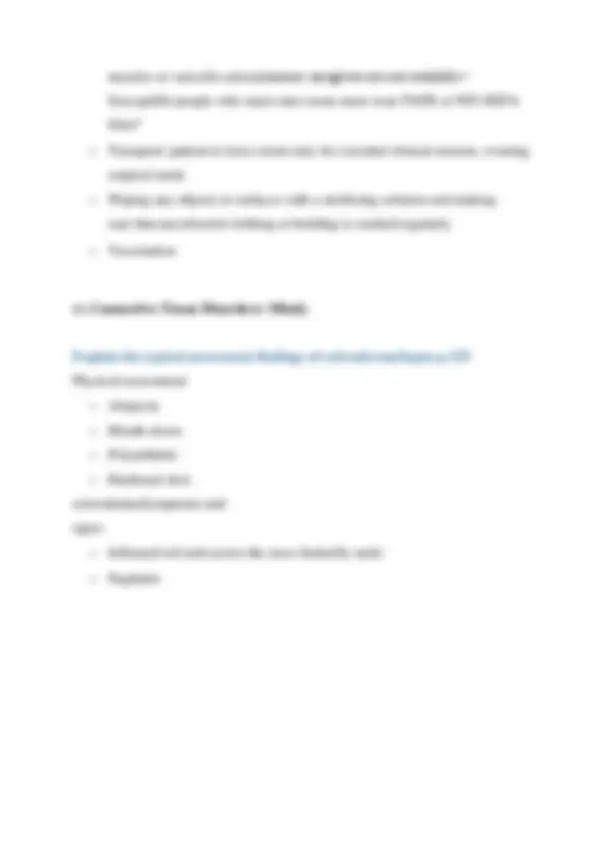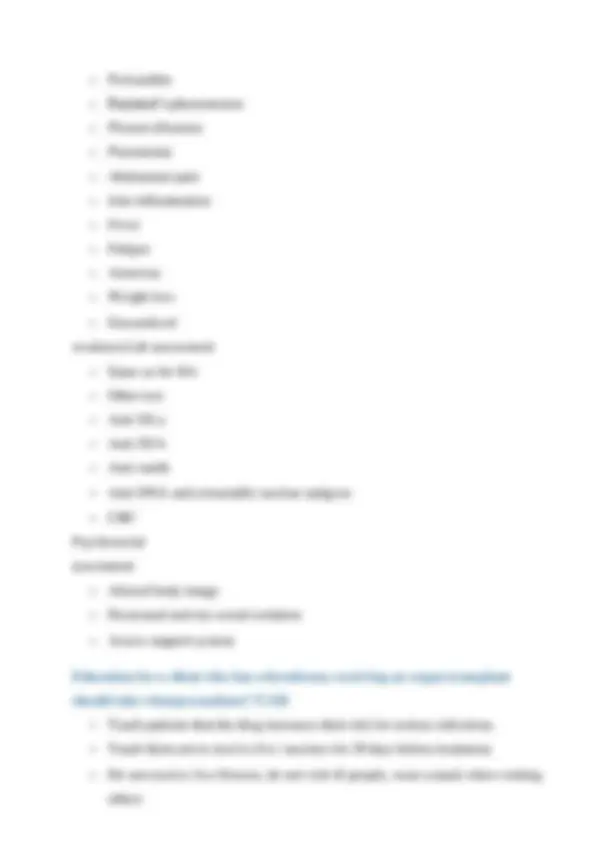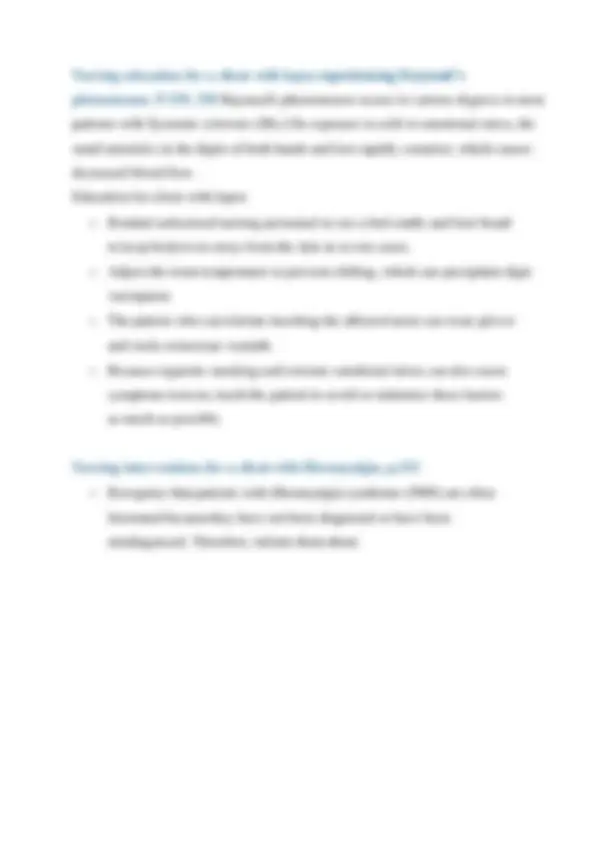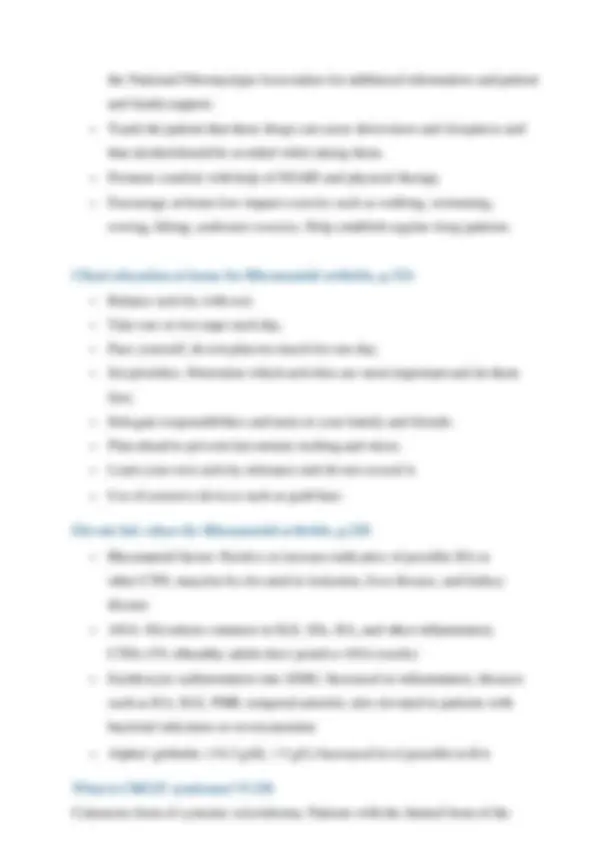Download NUR 2356 MULTIDIMENSIONAL CARE QUESTIONS WITH COMPLETE SOLUTIONS GUARANTEED PASS and more Exams Nursing in PDF only on Docsity!
NUR 2356 MULTIDIMENSIONAL CARE QUESTIONS
WITH COMPLETE SOLUTIONS GUARANTEED PASS
BRAND NEW 2025
1. Appropriate nursing actions: Nicole a) When a client falls - 1 st^ priority – check on patient for any injuries before that, guide the patient to the floor. b) Positioning to reduce injury for bony prominences - Place pillows under areas and elevate - Changes position for 2hrs Elevate calves to protect heels c) Reducing shear injury (med surg pg 447) - Avoid pulling and sliding patient against bed - Keep head of bed at a slight elevation - Make sure sheets and blankets have ripples in them that rub against the patient’s skin - Use others to assist to protect from shearing. d) Reduce urinary tract infection - Proper cleaning of Perineum – front to back e) Reducing pressure ulcers- factors that are contributors (med surg pg 448) Preventing Pressure Injuries Positioning
- Pad contact surfaces with foam, silicone gel, air pads, or other materials with pressure- redistribution properties.
- Do not keep the head of the bed elevated above 30 degrees to prevent shearing.
- Use a lift sheet to move a patient in the bed. Avoid dragging or sliding him or her.
- When positioning a patient on his or her side, position at a 30-degree tilt.
- Re-position an immobile patient at a frequency consistent with assessed needs.
- Do not place a rubber ring or donut under the patient's sacral area.
- When moving an immobile patient from a bed to another surface, use a designated slide board well lubricated with talc or use a mechanical lift.
- Place pillows or foam wedges between two bony surfaces.
- Keep the patient's skin directly off plastic surfaces.
- Keep the patient's heels off the bed surface using bed pillow under ankles or a heel- suspension device. Nutrition
- Ensure a fluid intake between 2000 and 3000 mL/day.
- Help the patient maintain an adequate intake of protein and calories. Skin Care
- Perform a daily inspection of the patient's entire skin
g) Appropriate measures in taking an oral temperature (module 1 slides55) h) Vital signs that can indicate post-surgical pain?
- Elevated Heart Rate
- Breathing rate can be elevated
- Elevated BP 2. Describe the following: Nicole a) Complications of amputations and type of pain (module 1 slide 10) Possibility of phantom pain b) Autonomy for a client requiring oral care (funds book pg 594 - 595)
- Brush the teeth twice a day.
- Use a soft toothbrush.
- Moisturize oral mucosa and lips every 2 to 4 hours.
- Use a chlorhexidine gluconate (0.12%) rinse twice a day during the perioperative period for patients who undergo cardiac surgery (adult patients).
- Use mouthwash inside the mouth twice a day for adult patients who are on a ventilator.
- Give the patients the oral supplies c) Fire safety measures and priorities (module 3 slides 12 &22) o Fires ▪ Home fires are the major cause of death and injuries ▪ Older adults & children < 5y/o have the highest risk. ▪ Most common causes of fires: ▪ Cooking fires ▪ Smoking ▪ Heating Equipment ▪ Home oxygen administration equipment: 75% of home fires involves oxygen, smoking materials are the ignition source
- Do not use microwave to heat formula - Do not sleep with mom and dad e) Client orientation to a new room may include what specifics
- Ensure they can use call light before you leave
- Show them where their personal items are and place them near to them
- Show them where all the furniture is at and walk them around it.
- Also show them where the bathroom is and how to get to it f) Delegation to an unlicensed assistive personnel (UAP) o Anytime there is concern over a finding from an unlicensed person - assess the patient yourself to confirm the concern o Things that can be delegated to unlicensed personnel ▪ Vital signs on a non-critical patient ▪ Moving/ambulating a patient ▪ Bedside glucose monitoring ▪ Bathing and documenting tasks 3. Describe the following: Casey a) Benefits of bathing for a client Cleans the body, stimulates circulation, provides relaxation, and enhance healing. b) Caring for a patient with dementia, specific nursing interventions promote patient orientation, use simple communication, decrease anxiety, keep the patient safe, and pro- vide continuity of care. (fund book, p. 787). As for assistance with procedures such as indwelling catheters or IV insertions. c) Normal temperatures of clients of all ages (infants, adults, elderly) Infant 97.7- 99.5, Adults 96.4 to 99.5, Elderly 96.8 average (due to loss of
subcutaneous fat) d) Main causes of accidental poisoning
- Young Children exposure is mainly due to improper storage of household chemicals, medicines, vitamins & cosmetics
- Older children and adolescents cause is due to suicide attempt, accidental experiment with recreational or prescription drugs.
- Adults poisoning occurs by misuse or abuse or prescription drugs, especially narcotics, tranquilizers and antidepressants ( module 3 , slide 8) e) Main purpose of incident report To give the health care facility and the healthcare professionals the opportunity to address the issue and prevent the occurrence of future incidents. f) Interventions for a patient with a DVT
- Patient education
because they do follow Western Medicine as first choice to promote health. Most adults are not likely to accept a blood transfusion. ( funds p. 332) b) Asian cultures and space People stand farther apart and touch less c) Jehovah’s Witness and blood transfusions View accepting blood transfusions or blood products as morally wrong. ( funds p. 332). However, it is vital for the nurse to educate o the client on the reasons why the blood transfusion is needed. d) Hindu clients and bathing Hindus prefer to wash in free-flowing water (e.g., a shower instead of a tub bath). If a shower is not avail- able, provide a jug of water for the person to use in the bath. Women are modest and usually prefer to be treated by female medical staff (funds p. 333) e) Catholics and last rights- who does the nurse communicate to?
A Roman Catholic who is seriously ill might wish to receive the sacrament of anointing the sick. This sacrament, once known as the last rites, can be repeated if the person recovers and then be- comes ill at a later time. Only a priest can hear the sacrament of reconciliation (confession), during which God, through the agency of the priest, grants forgiveness for past sins. (funds p. 332) f) Describe empathetic statements
- Desire to understand and be sensitive to feelings, beliefs and situation. o As the nurse, adaptation to different style, tone, vocabulary and behavior is important to create the best approach for each patients’ situation.
- Place your-self in the patient situation. Think about “how would I want to be treated if it was me? This will help you: o Appreciate everyone uniqueness o Understand the needs (module 2, slide 13) g) Describe therapeutic communication
- Client-centered communication directed to achieve the patients’ goal.
- Has 5 key characteristics
- Key skills to establish a therapeutic relationship, express interest, concern, caring perception, provide and obtain healthcare information (module 2, slide 12) h) How can communication be improved with a client wearing hearing aids? - Position yourself directly in front of the patient.
- Ensure that you are not sitting or standing in front of a bright light or window, which can interfere with the patient's ability to see your lips move.
- Make sure that the room is well lighted.
- Get the patient's attention before you begin to speak.
- Maintain orientation to time such as a clock, and calendar 5. Immobility/mobility: Janett What exercises can improve mobility? Range of motion (Passive & Active) Weight baring exercise (page 208) Describe different types of passive range of motion exercises. (flexion, extension, abduction, adduction, circumduction, internal/external rotation, opposition) (page 506) Explain why certain medications place clients at risk for pressure ulcers. Some medications alter the blood flow. This causes less blood to go to pressure areas. May lead to necrosis. (page 81) What are the benefits of exercise? Bone reformation and growth, Cardiovascular health promotion, Promotes balance and stability, Reduce stress and increase energy levels, Improves pulmonary circulation, skeletal development, skin tone, Reduces systemic inflammation (page
What are the negative effects of immobility? Osteoarthritis, Rheumatoid Arthritis, Loss of muscle strength, Impaired balance, Altered join mobility, Decreased stability, Osteoporosis, Depression, isolation, anxiety, and mood change, Can cause decreased peristalsis, DVT(page
Interventions to reduce the risk of contractures Gently straighten out contracted extremity, fingers, Mobility-encouraging interventions such as passive ROM, and rotation. Flexion and extension exercises,
These interventions should be performed about every 2hrs and as needed if the contractures are present (page 843) What are the effects of immobility on the respiratory system? Pulmonary embolisms, pneumonia. Decreased depth of respirations, decreased ability to cough, atelectasis (page 831)
6. Diseases that contribute to immobility: Janett Assessment of osteoarthritis. progressive deterioration & loss of cartilage & bone in one or more joints (crepitus), history (of join pain, pain management, history of joint injury, weight history, family history, affecting of the ADL’s), atrophy of skeletal muscle from disuse, limp, lab assessment (erythrocyte sedimentation rate, c- reactive protein) (page 306) Non-pharmacological interventions for rheumatoid arthritis.
- 4 - 6 weeks of antibiotic therapy for acute osteomyelitis
- May require wound irrigation & medicated beads that are directly in contact with the wound
- May be in contact isolation precautions if area is draining copious amounts of drainage
- Hyperbaric oxygen therapy (Module 5 PPT; slide 50) 8. Describe the following: Angela How does a nurse perform a neurovascular assessment? If negative findings occur, what should the nurse do next? Assessment of the extremities to evaluate sensory & motor function (neuro) & peripheral circulation (vascular). Components: (bilateral comparison) pulses, capillary refill, skin color,
temperature, sensation, & motor function (movement). Pain & edema are also assessed. (5 P’s: Pain, Pulse, Pallor, Paresthesia, & Paralysis) A doppler is used to determine blood flow. (Module 5 PPT; slide 15) Negative findings: a. Assess BAC & provide as needed b. Expose the area of injury to assure accurate assessment c. Control any bleeding. Apply direct pressure to bleeding site or pressure artery above the fracture d. To prevent shock, position patient in a supine e. Splint the injury Manage pain with an opioid medication (Module 6 PPT; slide 15) What is the normal aging process for bones? It undergoes a continuous process of formation & resorption, or destruction, at equal rates until the age of 35 years. In later years, bone resorption increases, decreasing bone mass & predisposing patients to injury, especially older women. Osteopenia, less synovial joint cartilage, muscle atrophy (Medical-Surgical Nursing e-textbook; pg. 1005) What types of clients are at greatest risk for a DVT?
- Decreased mobility or immobility
- Older adults (40 years or older)
- Family history or history of DVT, VTE, PE varicose veins, or edema
- Oral contraceptives use
- Smoking
- Decreased cardiac output
- Hip fracture or total hip or total knee surgery
- Obesity
- Cancer
- Spinal cord injury
- Keep top 2 bed rails up; maximum 3 bed rails total
- Keep call light within reach
- Ensure proper lighting for patient to see at night 9. Orthopedics: Alicia a) Appropriate interventions for a patient with a cast with a negative assessment.
- Teach patient and family to smell area for mustiness/unpleasant odor; teach to never put anything inside cast (hanger, pencil). Circulation: teach patient to assess for circulation at least daily, including the ability to move the area distal to the extremity, note numbness, increased pain. Pg. 1039 b) Halo traction and problems with infection. What are priority steps?
- Follow hospital policy for pin site care which may specify use of solutions such as saline, and Vaseline dressings. Monitor vital signs for indications of possible infection, fever, purulent drainage from pin site. Send cultures prior to the start of an antibiotic. c) What are complications of hip surgery?
- Blood clots, infection d) Describe stages of bone healing.
- Stage 1: 24 - 72 hours after injury hematoma formation
- Stage 2: 3 days- 2 weeks granulation tissue invades hematoma forming fibrocartilage.
- Stage 3: 3 - 6 weeks callus formation
- Stage 4: 3 - 8 weeks callus is gradually reabsorbed and transformed into bone
- Stage 5: 4- 6 weeks to a year consolidation and remodeling of bone to continue to meet mechanical demands. Pg. 1032
e) Explain the purpose of traction
- Application of a pulling force apart of the body to provide reduction alignment, rest, and is last resort to decrease muscle spasm and prevent/connect deformity and tissue damage. Pg. 1040 f) What is compartment syndrome?
- Limb threatening complication caused by severe neurovascular impairment manifested by increasing alterations in levels of comfort (pain even after analgesics are given) and paresthesia (painful tingling and numbness). g) Education for an elderly client at risk for falls at home
- Physical activity/exercise, weight bearing for bone strength
- Home mods: handrails, slip-proof rugs, adequate lighting, avoid scatter rugs, slippery floors, clutter, encourage use of visual, hearing, ambulatory assistive devices.

